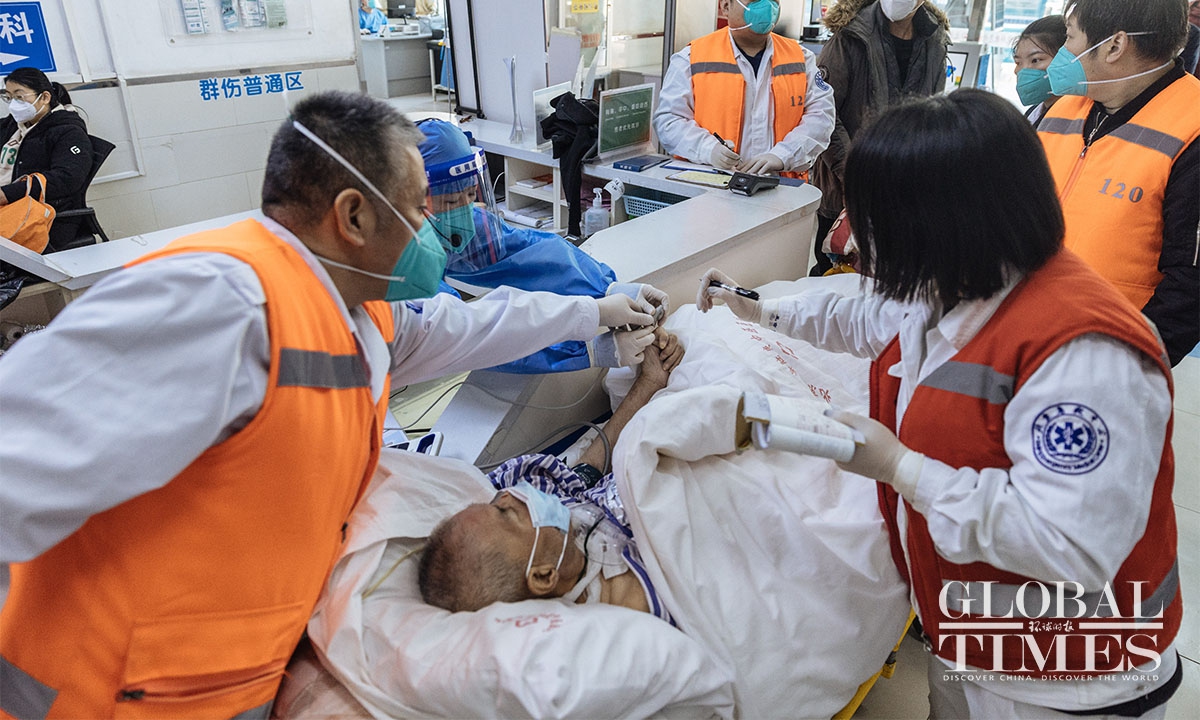Better equipment, more experiences help Chinese hospitals treat severe COVID-19 cases

Photo: Li Hao/GT
As COVID-19 infection curve has already peaked in several major Chinese cities such as Beijing, Global Times reporters talked to several major hospitals to see for medical workers, whether the "hardest time" has already passed. Doctors said that the number of patients admitted into emergency rooms and fever clinics has dropped, yet the number of severe cases is still high, and hospitals are also coping with the lack of medical workers.
Hospitals nationwide are making strenuous efforts to make up the shortage of hospital staff, upgrading capacity and expand medical resources in order to pull through the outbreak wave in an orderly and safe manner. Despite challenges, many doctors believe China will weather the wave soon with medical workers' hard work, the country's swift action in tackling difficulties, and the past three years' experiences.
In the lobby of Daxing People's Hospital in Beijing, masked patients were waiting in order to be received by doctors; nurses hustling through to attend patients in need. It is one of the busiest days for doctors in this hospital at capital's Daxing district, as Beijing is busy treating COVID-19 patients after China relaxed its COVID-19 responses last month.
Yet doctors from the hospital told the Global Times that the most difficult peak time in their hospital appears to be over.
According to Yuan Jinglin, deputy dean of the hospital, the hospital's emergency department and fever clinic received more than 1,000 patients per day at peak time, which had fallen by the end of December, and that dozens of whom in very severe situation need emergency treatment.
Since this month, Yuan said the number of patients received by the emergency department alone has seen a decline from 780 people at the peak to about 500 in recent days.
Wu Zunyou, chief epidemiologist of the Chinese Center for Disease Control and Prevention, said last week that virus circulation in major Chinese cities, such as Beijing, Tianjin and Chengdu has already peaked.
However, Yuan said that despite slight decline, the number of severe cases is still high in their hospitals, especially those elderly with severe underlying diseases. Doctors told the Global Times that their focus at current stage is to concentrate resources in saving severe cases and prevent deaths.
Yuan said that the hospital already equipped with 80 percent medical equipment they need to treat the rising number of severe cases, and they are no longer in need of ventilators and oxygen generating plants.
The biggest problems, according to Liu Xia, director of the fever clinic of Daxing People's Hospital, is lack of medical staff. "Most hospitalized cases are over 80 years old, they are in need of monitoring. In our infectious and fever clinics, we still need one third more of the staff in order to cope," said Liu.
Hard work
Daxing People's Hospital offers a peek inside the current challenges that hospitals face in major Chinese cities, which were among the first to feel the pressure of the country's exit wave.
In an interviews with the Global Times previously, Wuhan's Tongji Hospital, a major facility for the city's COVID-19 patients, said that during the recent week, the hospital has admitted a surging number of patients in its fever clinic and emergency departments, with 2,200 people visiting those two departments on a daily basis.
On December 30, 2022, 92.32 percent of pneumonia patients that were hospitalized in the hospital showed severe symptoms.
A similar situation also struck Jiangsu Province Hospital, whose emergency rooms saw soaring number of patients from previous 500 to 1,200 per day in recent days.
Chen Xufeng, a doctor at Jiangsu Province Hospital, told the Global Times that the biggest difficulty for them right now is that more medical workers are getting infected whilst more patients are swarming into the hospital.
Many doctors in Beijing are insisting on working even after being infected with COVID-19, if they experienced only mild symptoms. Liu from the Daxing People's Hospital told the Global Times that sometimes, doctors nearly passed out, and then they were escorted out to rest for a while; after that they would continue treating patients.
Cao Quan, an official from ICU department at the Jiangsu Province Hospital, told the Global Times that doctors at the ICU unit now shoulder twice or triple amount of work than usual but none of them quit or give up. They all hoped to take leave as late as possible while get back to work sooner, said Cao.
Wuhan's Tongji Hospital, in order to elevate their ability of treating surging number of patients, broke the traditional branches and allowed doctors of all disciplines to accept patients with COVID-19. The hospital's beds for patients with severe symptoms have increased to 1,041 from previous 546; and 60 percent of whom are for patients with respiratory diseases.
Yuan also said that the shortage of medicine that crippled hospitals in Beijing in early December is not a problem anymore. For example, the hospital began to distribute Pfizer's COVID-19 treatment drug Paxlovid to elderly patients with severe diseases.
Jiao Yahui, director of the Medical Administration Bureau of the National Health Commission, said last week that hospitals should expand their medical resources and increase capacity to offer medical service. She instructed cities to upgrade their designated hospitals in treating COVID-19 patients, and major hospitals to expand wards for severe cases and ICU beds.
Adequate preparation
The influx of patients and the strain they impose on Chinese medical system have become target of foreign media's smearing of China's relaxing of its COVID-19 response recently. They claimed that hospitals are ill-prepared for such "abrupt" decision and thus are struggling to cope with current case ballooning.
Yuan said before the major adjustment of China's COVID-19 response in December, the hospital's preparation of medical staff and supplies to cure COVID-19 patients has never stopped during the past three years. Previous anti-epidemic policy required the hospital to set separate wards for patients infected by COVID-19, prepare medical equipment like ventilators and oxygen cylinders, and train medical staff for COVID-19 treatment, said Yuan.
"Then we faced surging number of patients, mostly young people, rushing to the fever clinic and now focused on the treatment of severe cases as more elderly got infected. We have always been adjusting the deployment of medical staff and reserve of supplies in accordance to the changes of the situation."
Virulence of Omicron has decreased, said Ran Xiao, also from Tongji Hospital, noting that compared with three years in the past, hospitals also have more choice of medicine, better equipment and have a mature treatment routine to follow.
Zhou Ning, a doctor from Wuhan's Tongji Hospital, told the Global Times that the experience accumulated during the past three years endows with him more confidence in the face of the virus. "Now we already have a clear picture of the virus, know how to treat severe cases, where to invest more resources. We don't have the panic and helplessness that struck us three years ago."
Photos
Related Stories
- XBB unlikely to cause new infection peak in China: expert
- Hungarian analysts hail China's new COVID approach
- China to further implement health protection at earlier stages
- China calls for avoiding politicization of COVID-19 pandemic: spokesperson
- Large-scale epidemic from XBB subvariant unlikely in short term: China CDC
- Putting people first central to China's COVID response
Copyright © 2023 People's Daily Online. All Rights Reserved.









